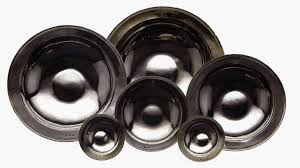The Armada Service
|
Armada Service at the British Museum | |
| Material | Silver |
|---|---|
| Size | Diameter 12.1cm (min) |
| Created | Late 16th - early 17th Century AD |
| Present location | British Museum, London |
| Registration | M&ME 1992,6-14,1-26 |
The Armada Service is a set of at least 31 silver dishes that was owned by Sir Christopher Harris (c. 1553–1625) and his wife, Mary Sydenham, of Radford House at Plymstock in Devon, England. Twenty-six of these dishes are now owned by the British Museum.
History
During the 16th and 17th centuries amassing silver was usual for wealthy English families, including royalty, the rich and the famous. Such collections served two distinct purposes – to boost family prestige and pride and to act as an investment. In the case of the silverware in the Armada Service (also known as the Tudor Service) the gilded silver, variously dated between 1581 and 1601, was collected by Sir Christopher Harris, of Radford House in Devon, and his wife Mary Sydenham, as the ancestors of the Harris family of Radford.[1][2] Harris was an appointed Commissioner for Booty at Plymouth under Sir Walter Raleigh. He was elected a Member of Parliament for Plymouth in 1584 and was Vice-Admiral of Devon during the reign of James I.
Importance
One source claims that the service is "one of the most important groups of English silver to have been found in England."[3] The parcel gilt dishes were engraved on their sides with the arms of Harris and Sydenham, and bear London Hallmarks for the years 1581, 1599, 1600 and 1601.[4] [5][6] As a set of relatively plain objects, in which the bullion value may have exceeded its artistic worth, this Service represents "the unique survival of a type of utilitarian plate which is listed in the inventories of the gentry and aristocracy of the late Tudor and early Stuart periods."[3][7]
Etymology
The etymology of the hoard's name is subject to speculation by scholars. Notably, the Spanish Armada debacle/triumph occurred in 1588. It may have a connection to New World silver captured and pilfered from Spanish treasure ships. 31 pieces were "commissioned to mark the conquering of the Spanish naval fleet and used at a dinner thrown" at Harris's estate in Radford.[8] Some have hypothesized a connection to the Madre de Deus (Mother of God), a Portuguese ship captured by the English circa 1590.[7] However, Sir Christopher Harris worked for Sir Walter Raleigh in the British Admiralty during the Anglo-Spanish War (1585–1604). His acquisition of these dishes in a relatively contemporaneous time may mean they "represent the profits of his office".[5]
Discovery
During the English Civil War (when huge amounts of silver were melted down to pay for the armies), the set was buried on Dartmoor to avoid being looted by Parliamentary troops. It was not discovered again until 1827, when three farm labourers, employed by the Splat company of Brixham, discovered it in a cave while digging to increase the storage capacity for the company's holding of potatoes. The local newspaper reported that "upwards of 30 dishes" had been found.[9] The Splat family sold the dishes at Christie's in London for £11,500 in June 1911.[7]
Subsequent history
26 dishes were acquired by the British Museum in July 1992 (when they were valued at £900,000).[10] In April 2013 an additional spice dish, from the original service, was valued on BBC One’s Antiques Roadshow, by the programme’s silver expert Alastair Dickenson, at "about £100,000."[9] Dickenson acquired for a client two related pieces — which had been taken to the southern United States before being repatriated to England — for £135,000 at auction at Lawrence’s of Crewkerne. The whereabouts of the missing "three" [sic] pieces are unknown.[8]
See also
References
- ↑ Susan M Pearce (1995). On Collecting: An Investigation Into Collecting In The European Tradition. Routledge. pp. 95–. ISBN 978-0-415-07561-9. Retrieved 14 April 2013.
- ↑ Philippa Merriman (2009). Silver. Harvard University Press. pp. 36–. ISBN 978-0-674-03094-7. Retrieved 14 April 2013.
- 1 2 Thornton, Dora; Cowell, Michael (March 1996). "The 'Armada Service': a Set of Late Tudor Dining Silver". The Antiquaries Journal. The Society of Antiquaries of London/Cambridge Journals On Line. 76: 153–180. doi:10.1017/S0003581500047454. Retrieved 10 April 2013.
- ↑ Caygill, Marjorie (1999). The British Museum: A-Z companion. British Museum Press. p. 28. ISBN 978-0-7141-2157-4. Retrieved 11 April 2013.
- 1 2 "The Armada Service". British Museum. Retrieved 10 April 2013.
- ↑ "Silver Armada Dishes". The Silver Company, London. Retrieved 10 April 2013.
- 1 2 3 Hersey, Stewart (1 May 2009). "The Silver Armada Dish and Their History". GoArticles.com. Retrieved 10 April 2013.
- 1 2 "Alastair's Armada silver". Homes & Antiques. BBC Worldwide/Immediate Media Company. Retrieved 11 April 2013.
- 1 2 "Antiques Roadshow – Series 35 – 18. Cheltenham Town Hall 1". bbc.co.uk. 2013. Retrieved 11 April 2013.
- ↑ Pearce, Susan M (1995). On Collecting: An Investigation Into Collecting In The European Tradition. London, New York: Routledge. p. 296. ISBN 978-0-415-07561-9. Retrieved 11 April 2013.
Further reading
- Thornton, Dora (Spring 1993). "The Armada Service". British Museum Magazine.
Armada Dishes in Sterling Silver
